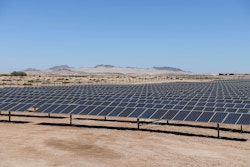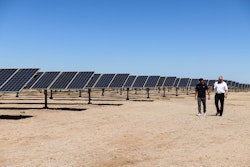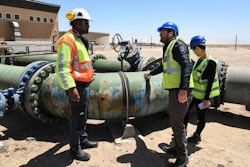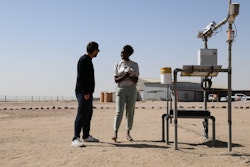All eyes on Namibia: a rare bird in the energy world
Namibia: 81st and last stopover on the African continent for Energy Observer. Namibia is different from all the other African countries our catamaran encountered. It is not just because of the endless dunes that line the scenery, energetically too it is a rare bird characterized by a complexity we have never witnessed before.
Namibia is a geographically large country, mainly made of deserts, and thus with a very small population of about 2.5 million people. It is one of the driest countries in Sub-Saharan Africa and one of the most vulnerable to climate change, which is already hitting its fragile ecosystems and complicate socio-economic development.
An open market, an inevitable dependency
In 1990, when Namibia gained its independence from South Africa, the country’s economy was marked by a narrow industrial sector and a strong dependence on the production and export of primary commodities. Today, as it was then, it still relies on a handful of sectors - mining, rain-fed agriculture, fishing, manufacturing and tourism – and imports almost all its goods. Food products, machinery, equipment and chemicals, everything comes from abroad, most from South Africa and the rest from Zambia, DRC, China and Germany.
The same applies to energy. In fact, despite its small population, a low electrification rate of 56% and a domestic generation capacity of about 680 MW - of which 509.5 owned by the state-utility NamPower and the rest operated by IPPs - Namibia can only fulfil less than half of its electricity needs. That is because generation plants rarely, if ever, produce at full capacity. This leaves the country in a severe power deficit, forcing it not only to look for power elsewhere, thus becoming dependent on electricity imports from neighbouring countries, but also, as a consequence, to experience one of the highest bulk electricity tariffs in Southern Africa, with 1.82 Namibian dollars per kWh, namely 0.12 euro/kWh.

Energy Observer at the Solar Andis Central in Namibia
Today 60% of the electricity supply is sourced from abroad, mainly through bilateral contracts from South Africa’s electricity provider Eskom, which is already struggling to give enough power to its own country causing continuous power shortages and load shedding. The rest is mainly ensured by imported fossil fuels (petroleum and coal) and hydropower from the Ruacana Hydro Power Station, Namibia’s biggest national energy source, which has already started experiencing the threats of climate change. The situation has to change.
Multiple resources, multiple assets
If peak demand is still relatively modest today, there is no doubt it will increase in the coming years in the attempt to electrify households which still lack electricity. According to the National Integrated Resource Plan (NIRP) - a 20-year electricity sector development plan aiming to provide an indication of Namibia’s electricity demand - this demand is expected to rise to 930 MW in 2025 and hit 1348 MW in 2030. The challenges ahead are many: it won’t be easy to meet these needs, face peak power challenges, reduce dependency on imported electricity, tackle transmission congestion on the import corridor and while addressing the decline in surplus generation within the Southern Africa Development Community. But no panic, this territory is blessed with enough renewable potential to become a regional powerhouse that could significantly reduce sub–Saharan Africa’s reliance on carbon-based fuels.

Victorien Erussard at Solar Arandis Central in Namibia
Even though as of today Namibia has developed just about 200 MW of solar PV capacity, which contribute to approximately 25% of local generation, the country is perfectly positioned for photovoltaic and concentrated solar energy production. With vast open landscapes, clear skies, over 300 sunny days per year and a well-tempered climate, the potential for solar generation is immense. Here the power output achievable by a typical utility-scale PV system stands at 5.38 kWh/kWp/day, meaning a PV system with an installed capacity of 1 kW can generate 5.38 kWh every day: twice as much as in Germany and 40% more than in China, the solar giant. No region in the world, except from Chile, is better than Namibia for PV generation.

PVOUT values in kWh/kWp/year
Solar is not the only asset, Namibian soil is rich in mineral resources, which is one of the main reasons for the South African apartheid government’s efforts to retain control over this nation throughout its struggle for independence. Namibia was the world’s third largest producer of uranium and the eight-largest producer of diamonds in 2022. Lithium, which is crucial for storing renewable energy, and rare earth elements such as dysprosium and terbium, essential for permanent magnets in wind turbines or in the batteries of electric vehicles are abundant in the region. Zinc and cobalt can be found underground too. Namibia has a long tradition of mining and today the sector accounts for about 15% of its annual GDP, employing about 16 000 people.
Desalinisation to boost mines and hydrogen
A lot of water (and energy) is required to extract mineral resources and it is not obvious for a desertic country to meet such gigantic needs for water, especially when populations already need it to live. Fortunately, Namibia has an easy access to seawater, then what’s better than turning it into freshwater by means of a desalinisation system? As a matter of fact, such a plant has been already built in the Erongo region. With a production capacity of roughly 12 million cubic meters of fresh water per year, namely the equivalent of about 4800 Olympic swimming pools, the Erongo desalinisation plant it is the biggest reverse osmosis plant in Southern Africa. Its production is almost entirely intended for use in the uranium mines of the Erongo region but could in the future, upon capacity expansion, meet the potable water needs of cities and, why not, of a hydrogen economy.

Victorien Erussard at the Orano desalinisation plant in Namibia
In fact, if the government plans to increase production from renewables to reduce energy dependence and the - albeit negligible - contribution to greenhouse gases emissions, the national grid will have to integrate new energy storage solutions, including hydrogen. Green hydrogen is a commodity that Namibia plans to produce and export to the international market and that could help the country go from a very little industrialisation to an important one leapfrogging the carbon-heavy part of this process, that almost every- developed country went through. Hyphen Tsau Khaeb Project, Daures Green Hydrogen Village, Cleanergy Solution Namibia, Renewstable, the projects are diverse, some to produce ammonia and fertilisers, some to produce low-carbon hydrogen to export, some other for local energy storage. Projects will need time and fundings to see the light, but one thing is sure: Namibia lacks nothing to succeed in this industry.

Victorien Erussard with Tashiya Walenga, responsable for the HDF Energy project in Namibia
Accelerating efforts to reduce emissions is crucial for all nations, especially embracing sustainable energies. For a country like Namibia, this is a real challenge: this means expanding electricity supply, ramping up domestic sources to feed an economic development, simultaneously building a more resilient energy system and curbing emissions. The task is enormous but not impossible. However, let’s not forget that this country will need to accelerate its own transition before helping us succeed in ours.